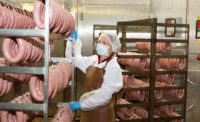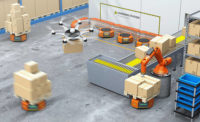Many of the issues that processors have with equipment on the slaughter floor have been around for a while now. And they tend to focus on tool ergonomics and the ability to sanitize and then maintain that equipment while operating in some very harsh working conditions, says Kurt Vogel, associate professor of animal science at the University of Wisconsin – River Falls.
From small to even large plants, stunning also can be an issue when it comes to humane handling, based on data from Humane Handling Enforcement on the U.S. Department of Agriculture’s website. These humane-handling enforcement violations are published with the details of the company’s actions.
“Generally, 80 to 85 percent of them are stunning failures,” says Terry Houser, associate professor and Smithfield Foods chair in meat science extension at Iowa State University, in Ames. For example, some processors use multiple attempts to stun, which is against the Humane Slaughter Act.
Slaughter equipment advancements
The good news is the industry continues to see advances on the quality of clean-in-place equipment. For example, the industry now has splitting band saws that have blade cleaners and sterilizers on board, Vogel explains. “Our newer equipment is being designed with such a focus on hygiene,” he adds.
From an ergonomics standpoint, slaughter equipment manufacturers have placed more focus on trying to isolate vibration, not unlike other types of tools that are used in other industries. “We’re starting to see that application in a lot of our tools that are on the slaughter floors, too,” Vogel says.
Another solution that’s been around for a while is the ability to adjust the interface with the worker. For example, changing the position of specific handle angles where the trigger might be located to activate the tool. “These are all things that help to tailor the equipment to the specific operator,” Vogel says.
These advancements in tools are helping to improve efficiency of operations in multiple ways. For example, if the equipment is a better fit for workers, that allows for a greater level of efficiency in how they operate the equipment while also reducing fatigue. The ability to clean equipment on the fly also helps, Vogel says.
More important than improving productivity is the fact that the newer equipment also improves food safety.
“It’s hot and it’s cold and it’s wet,” Vogel explains. “We’re using equipment that operates on electricity and hydraulics, and none of that mixes together, but I think that’s a place where we’ve just seen nothing but continuous improvement using higher-quality seals and assemblies that are more resistant to water. Equipment that’s easier to maintain.”
“We’re going to continue to see advances in leaps and bounds with how easy the equipment is to clean in place,” he says.
While more prevalent in the poultry industry, the meat industry also is seeing more automation being used.
“The final piece that I think is one of the ones that’s extremely exciting to watch is how we’re going to see more automation come into play here,” Vogel says. “I think we’ll start to see less and less handwork and more and more need for people that understand how to appropriately program and then tune equipment.”
Houser adds the industry needs more equipment manufacturers designing knocking boxes for small processors that are turnkey with overall better design. It would be better if more equipment was readily available for stunning pigs as well.
“Part of this issue, too, is that livestock have gotten a lot bigger over the last 30 or 40 years,” Houser explains. “These animals keep getting bigger and bigger, and many of these facilities were designed in the ’50s and ’60s. We’re using facilities that were designed for much smaller cattle and pigs, and we’re trying to get by with it. I hope we see some technology, certainly in the restraining department. We need to do better with that.”




